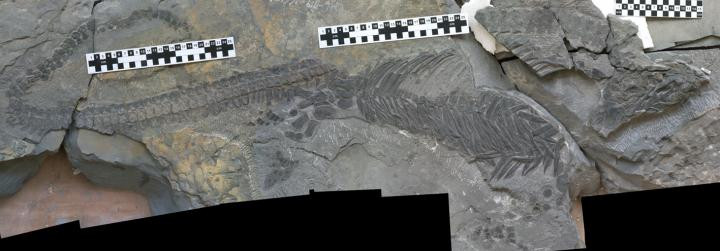Sclerocormus parviceps: Fast evolution of strange reptile sheds light on mass extinction events

A very strange reptile fossil has shed light on how life evolves following a mass extinction event. Researchers say the newly-discovered species of ichthyosaur evolved even faster than once thought, a discovery that provides a potential insight into how wildlife can regenerate under huge environmental pressures.
Two hundred and fifty million years ago, the Earth went through a period of mass extinction, and 96% of all marine reptiles disappeared. Scientists believed the early marine reptiles that emerged after the Permian-Triassic mass extinction evolved slowly, but the newly-discovered species contradicts this view.
Sclerocormus parviceps, as it is called, belongs to the Ichthyosaurs family, a group of very large marine reptiles who lived between 250 million years ago and about 90 million years ago - around the time of the earliest dinosaurs.
This reptile's characteristics however make it very different from its closest relatives, as the scientists explain in their research, published in Scientific Reports.
This suggests marine reptile species may have evolved and diversified to a greater extent than previously thought after the extinction, in the early Triassic era.
Different physical features
Ichthyosaurs are known to have long streamlined bodies, powerful tail fins and long beak-like snouts. The sclerocormus parviceps on the other hand had a short snout and a long tail without tail fins at the end. More surprising for the scientists, the species had no teeth, compared to its relatives who caught their preys using sharp, conical teeth. Instead, they hypothesise that the reptile used its short snout to suck up food like a syringe.
These differences among the ichthyosaurs group had never been observed before, and suggests the ichthyosaurs family was actually quite diverse.
"Sclerocormus tells us that ichthyosauriforms evolved and diversified rapidly at the end of the Lower Triassic period," explains lead author Olivier Rieppel, The Field Museum's Rowe Family Curator of Evolutionary Biology. "We don't have many marine reptile fossils from this period, so this specimen is important because it suggests that there's diversity that hasn't been uncovered yet."
Rapid evolution
The scientists say sclerocormus parviceps is so different from its relatives because it evolved very rapidly in order to survive environmental pressures and find food in a hostile post-mass extinction environment.
The discovery appears to contradict Darwin's model of evolution. "Darwin's model of evolution consists of small, gradual changes over a long period of time, and that's not quite what we're seeing here. These ichthyosauriforms seem to have evolved very quickly, in short bursts of lots of change, in leaps and bounds," Rieppel pointed out.
Although the study of such fossils cannot predict how animals will evolve today under the pressure of climate change, the scientists believe it can help them better understand how an ecosystem rebuilds itself after an extinction, and how current species will fare under increasing environmental changes.
© Copyright IBTimes 2025. All rights reserved.






















